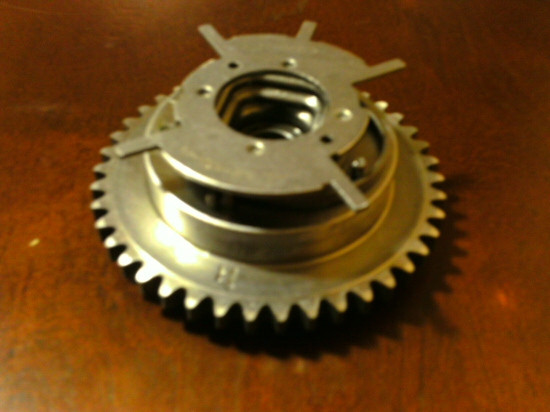Ford 5.4L Triton VCT Phaser Breakdown

With all of the problems related to the phasers on the 5.4L 3 valve Triton engine, I thought I would go ahead and get some pictures of the phaser torn down so that you can understand how it works. Although this article is mainly written with the 5.4L truck engine in mind, but it also applies to the 4.6L used in trucks, vans, and cars
The above picture is of the assembled phaser, also known as the camshaft sprocket, detached from the camshaft. Please note that both phasers are identical and are not fitted per side. Each one has two timing marks on it. One mark stating L and one stating R. Depending which side of the engine you install the phaser on will determine which timing marks you use. Also, please keep in mind that left and right sides of the engine are determined as if you were sitting in the drivers seat as normal. Therefore the R mark is for the passenger side and the L mark is for the drivers side. The center bolt has oil passages inside of it allowing oil to flow from the VCT Solenoid, through the camshaft, into the phaser. This bolt should be replaced anytime it is loosened or removed.

The above picture is the back side of the phaser. It is hard to tell from the picture but there is a small pin that rides in the hole in the center and is called the locating pin. This pin is actually what holds the shearing force from turning the sprocket separate from the camshaft. The pin fits into a small channel inside of the camshaft similar to that of a keyway in a crankshaft sprocket.
This particular phaser suffered catastrophic failure at the locating pin likely due to incorrect installation or missed camshaft alignment pin bore damage.

Above is a disassembled phaser. To disassemble them, you remove the 5 torx bolts. Those bolts go back on in particular positions because two of those bolts act as dowel rods for the spring. Inside of the phaser it looks similar to an oil pump, except that the vanes can only move so far, 60 degrees of rotation in fact. Its hard to see but deep down near those vanes are tiny oil ports. On the end of each vane is a small spring. Oil is pumped into a side of the vanes when the PCM wants to activate VCT. The outside spring helps return it to default. Oil forces the vanes to turn the center section of the phaser. The phaser requires approximately 26psi of oil pressure to adequately and quickly control movement. That is precisely why low oil pressure causes rattling.

Finally this is a picture of back wall of the phaser. Here you can see the locking pin, locking spring, and the oil ports that allow oil to the pin to disengage it. The pin strikes the back plate, slides through the offset center hole in the last picture, and locks into the front plate of the phaser. Oil pressure has to overcome the force of the spring to actually lift the pin out of the plate. This pin and spring is a common point of failure. The required oil pressure is approximately 10psi to unseat the pin.
Disassembling your phaser will likely ruin it. Do not try to reuse a disassembled phaser as engine damage can result. The spring has a lot of tension and can't be easily rewound by hand. Only partial disassembly is required to install the lockout kit.